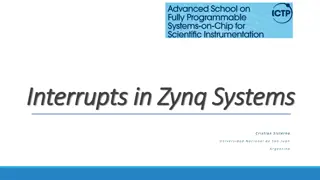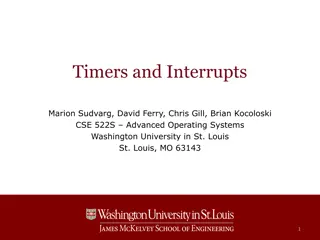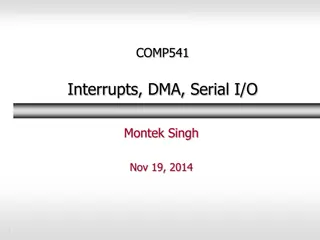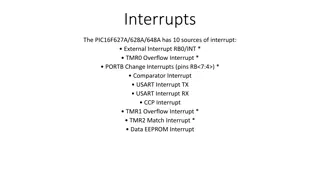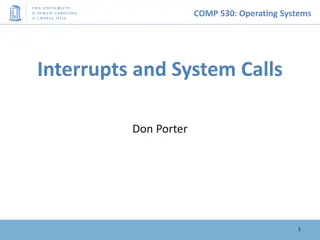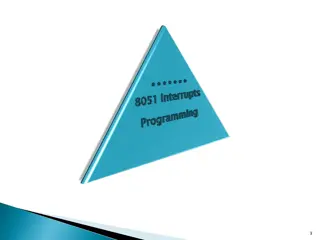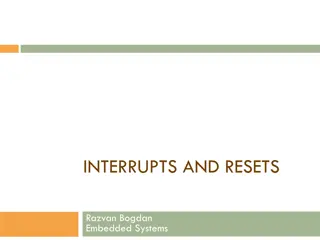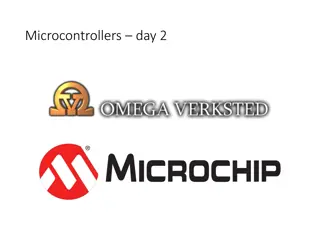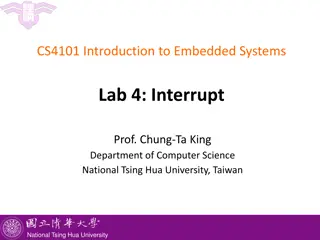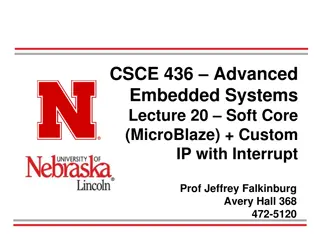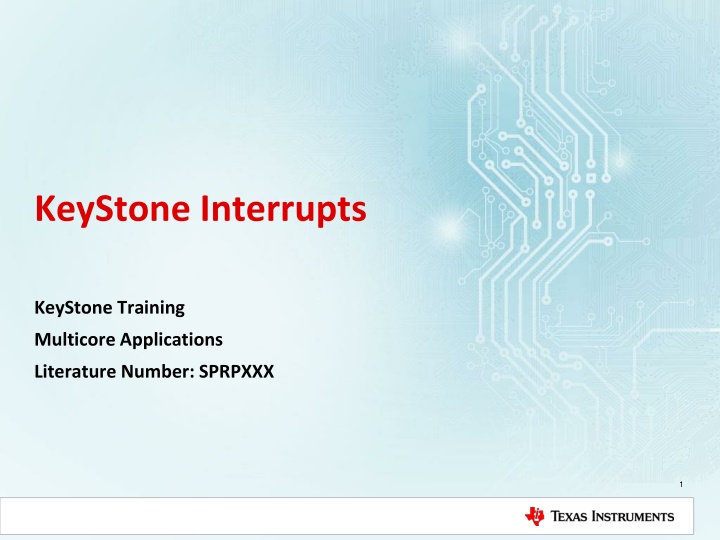
KeyStone Interrupts and Configuring HWIs for Multicore Applications
Learn about interrupt schemes in KeyStone, connecting events to ISRs, and configuring HWIs using BIOS for C66x CorePac in multicore applications.
Download Presentation

Please find below an Image/Link to download the presentation.
The content on the website is provided AS IS for your information and personal use only. It may not be sold, licensed, or shared on other websites without obtaining consent from the author. If you encounter any issues during the download, it is possible that the publisher has removed the file from their server.
You are allowed to download the files provided on this website for personal or commercial use, subject to the condition that they are used lawfully. All files are the property of their respective owners.
The content on the website is provided AS IS for your information and personal use only. It may not be sold, licensed, or shared on other websites without obtaining consent from the author.
E N D
Presentation Transcript
KeyStone Interrupts KeyStone Training Multicore Applications Literature Number: SPRPXXX 1
Agenda Interrupt Scheme Example 1: SPI Transmit Interrupt Example 2: HyperLink Interrupt ARM Interrupt Scheme 2
Interrupt Scheme KeyStone Interrupts 3
Link Events to ISR (Interrupt Service Routine) System Events ISR C66x CorePac QMSS SRIO GPIO SPI Hyperlink IPC
Link Events to ISR (Interrupt Service Routine) 124 Input Events System Events ISR C66x CorePac QMSS SRIO GPIO SPI Hyperlink IPC
Link Events to ISR (Interrupt Service Routine) 124 Input Events System Events ISR 48 C66x CorePac QMSS SRIO GPIO SPI Hyperlink IPC Primary events are connected directly to the CorePac To connect an event to ISR: 1. Connect primary event to one of the 124 maskable interrupt lines 2. Connect interrupt line to ISR CSL or BIOS API are used to connect events to interrupt lines and interrupt lines to ISR (Interrupt Service Routine).
Configuring an Hwi (Hardware Interrupt) Using BIOS Statically via GUI Example: Event 94 to the CPU HWI5 Use Hwi module (Available Products), insert new Hwi (Outline View) NOTE: BIOS objects can be created via the GUI, script code, or C code (dynamic). By the way, Event 94 is not connected to anything. It is reserved. 7
Configuring an Hwi Using BIOS Statically via GUI 8
Configuring an Hwi with BIOS Using Run-Time Functions The include file Hwi.h in the release MCSDK_3_0_4_18\bios_6_37_00_20\packages\ti\sysbios\family\c64p\Hwi.h Has the definition of the Hwi class Where do you find the Event Id #? 9
C66x CorePac Input Events (CorePac Events Only) From the System Event Mapping table in the C66x DSP CorePac User Guide: 128 CorePac events 22 assigned events NOTE: 4 used for event combining 7 reserved events 99 available events; The available events are connected to the device (mostly via CIC). Total of 124 unique Corepac input events - 10
C66x CorePac Events (CIC Output) for KeyStone II Devices 11
Configure HWI Using CSL CSL interrupt files are in the release: MCSDK_3_0_4_18\pdk_keystone2_3_00_04_18\packages\ti\csl\src\intc Include files: csl_intc.h csl_intcAux.h Source files in src/intc directory CSL_intcPlugEventHandler() CSL_intcInit() CSL_intcGlobalNmiEnable CSL_intcGlobalEnable() CSL_intcHwControl() CSL_intcOpen And many more NOTE: In addition to the mapping, the interrupt must be enabled: Global Enable activates the global interrupt register. Then enable specific interrupt can be activated. This presentation will not get into details of enabling the interrupts. 12
KeyStone II Interrupt Topology All events from all IP come to the interrupt controllers. Some are connected directly to C66x or other masters (EDMA, ARM, Hyperlink) Some are mapped by the interrupt controllers C66x CorePac0 C66x CorePac1 C66x CorePac2 C66x CorePac3 CIC0 C66x CorePac4 C66x CorePac5 C66x CorePac6 Events CIC1 C66x CorePac7 HyperLink EDMA CC0 EDMA CC1 CIC2 EDMA CC2 EDMA CC3 EDMA CC4 ARM A15 CorePac Peripherals 13
C66x CorePac Secondary Events CIC Interrupt Controller (3 instances) Channels Events 124 Input Events System Events Dedicated Interrupt Broadcast Interrupt ISR Fixed Connection Fixed Connection C66x CorePac SRIO GPIO SPI Hyperlink IPC Secondary events are connected to CIC and from there they are connected to the CorePac.
CIC to C66x CorePac Connections Event Number: CorePac Input Event Event Name: CIC Output Line CIC Interrupt Controller (3 instances) Channels Events 124 Input Events System Events Dedicated Interrupt Broadcast Interrupt ISR Fixed Connection Fixed Connection C66x CorePac SRIO GPIO SPI Hyperlink IPC 15
Connecting System Events Mapping (Connecting) System Events (Input to CIC) to Channels (Output of CIC) CIC Interrupt Controller (3 instances) Channels Events 124 Input Events System Events Dedicated Interrupt Broadcast Interrupt ISR X Fixed Connection Fixed Connection C66x CorePac SRIO GPIO SPI Hyperlink IPC Secondary events are connected to CIC and from there they are connected to the CorePac. 16
CIC Mapping API Read the following Wiki: http://processors.wiki.ti.com/index.php/Configuring_Interrupts_on_Keystone_Devices CSL APIs: For KeyStone II (MCSDK 3.x), there are two include files: csl_cpIntc.h csl_cpIntCAux.h SysBios APIs: MCSDK_Y_XX\bios_6_BB_AA_ZZ\packages\ti\sysbios\family\c66\tci66xx cpInitc.h cpInitc.c 18
Example 1: SPI Transmit Interrupt KeyStone Interrupts 19
Example 1: Connect SPIXEVT to CorePac ISR 66AK2H12 has multiple instances of SPI; We will look at SPI 0. SPIXEVT is NOT a primary event so it should be mapped via CIC. The next slide shows the system events that are associated with SPIXEVT. 20
Connect SPIXEVT to CorePac ISR SPI_0_XEVT is input event number 56 to CIC. What channel should be used? Table 5-22 shows the C66x CorePac Input Events. There are multiple CIC output events that are connected to C66x CorePac. Some of these events are broadcast events (e.g, connected to all 4 CorePacs that CIC supports) Some are individual CorePac events. 22
Connect SPIXEVT to CorePac ISR Eight events (56 to 63) coming out of the interrupt controller are broadcast events. They are connected to CIC output channels 0 to 7 respectively. This example uses C66x input event 63, which is connected to CIC_OUT7. 23
Connect SPIXEVT to CorePac ISR They are other events from the interrupt controller that could be considered (either broadcast or single core) The ARM GIC has 480 input events and 12 of them are connected to SPI. 24
Connect SPI 0 Transmit Event to CorePac 3 ISR CorePac 0 Disable event 63 in the interrupt controller CorePac Interrupt Controller CIC 0 (Chip Interrupt Controller) CorePac 1 SPI 0 XEVT Signal number 56 into CIC 0 Disable event 63 in the interrupt controller Connect event 56 (input) to CIC 0 output event 7, which is broadcast to CorePacs 0, 1, 2, and 3 as input event 63 CorePac Interrupt Controller CorePac 2 Disable event 63 in the interrupt controller CorePac Interrupt Controller CorePac 3 Enable event 63 in the interrupt controller and connect it to an ISR CorePac Interrupt Controller 25
CSL Map System Event (CIC Input) to Output csl_cpIntCAux.h shows the APIs that connect system events to channels (e.g., the output of the CIC). Connecting channel events to interrupt queues is done using CSL or SYSBIOS, as described previously. Error = CSL_CPINTC_mapSystemToChannel(hnd, 56,7) ;//CSL Error = CpIntc_mapSysIntToHostInt(0, UInt 56, 7); // BIOS 26
Example 2: HyperLink Interrupt KeyStone Interrupts 27
Example 2: HyperLink Interrupt MCSDK includes examples of interrupts originating from peripherals: MCSDK_3_01_12\pdk_keystone2_3_00_01_12\packages\ti\drv Consider an example using HyperLink, where an interrupt is sent from Hyperlink 0 to a C66x Corepac. 28
Hyperlink Interrupt 0 Table 5-24 of 66AK2H12- CIC0 Input Events Event number 111 (ox6F) is HyperLink 0 interrupt. Next, this interrupt is connected to a CorePac 29
Hyperlink Interrupt 0 to CIC Input static int hyplnkExampleInitChipIntc (void) { CSL_CPINTC_Handle hnd; // I some functions hidden here (enable/disable interrupts, etc.) CSL_CPINTC_mapSystemIntrToChannel (hnd, CSL_CIC0_HYPERLINK_0_INT, hyplnk_EXAMPLE_INTC_OUTPUT); // I some functions hidden here (enable/disable interrupts, etc.) return 0; } CSL_CIC0_HYPERLINK_0_INT = 111 What about hyplnk_EXAMPLE_INTC_OUTPUT? 30
Hyperlink Interrupt 0: CIC Output to CorePac Use CorePac input event 45 It could be any one of other CIC_OUT lines (look at the complete table for even more) 31
Hyperlink Interrupt 0: CIC Output to CorePac Event 45 on C66x CorePac N is connected to CIC output 64 + 10 x N: Core 0 event 45 is connected to CIC output event 64 Core 1 event 45 is connected to CIC output event 74 Core 2 event 45 is connected to CIC output event 84 Core 3 event 45 is connected to CIC output event 94 The code from the previous slide will map CIC 0 input event 111 to output event 64 (or 74, 84, depending on which core is used). 32
ARM Interrupt Scheme KeyStone Interrupts 33
Following GPIO 0 From Table 5-23 of 66AK2H12: ARM CorePac Interrupts 36
From the File gpio-keystone.c /git/linux-keystone/drivers/gpio static int keystone_gpio_irq_map(struct irq_domain *h, unsigned int virq, irq_hw_number_t hw) { struct gpio_bank *bank = h->host_data; irq_set_chip_data(virq, bank); irq_set_chip_and_handler(virq, &keystone_gpio_irqchip, handle_simple_irq); set_irq_flags(virq, IRQF_VALID | IRQF_PROBE); irq_set_irq_type(virq, IRQ_TYPE_NONE); return 0; } 37
From the File gpio-keystone.c /git/linux-keystone/drivers/gpio static void gpio_irq_enable(struct irq_data *d) { struct gpio_bank *bank = irq_data_get_irq_chip_data(d); u32 mask, status = irqd_get_trigger_type(d); struct gpio_regs *regs = bank->regs; int gpio; gpio = d->hwirq - bank->base; mask = 1 << gpio; if (status & IRQ_TYPE_EDGE_FALLING) __raw_writel(mask, bank->reg_base + regs->set_fal_trig); if (status & IRQ_TYPE_EDGE_RISING) __raw_writel(mask, bank->reg_base + regs->set_rise_trig); } 38
For More Information C66x DSP CorePac User Guide http://www.ti.com/lit/SPRUGW0C KeyStone Architecture Chip Interrupt Controller (CIC) User Guide http://www.ti.com/lit/SPRUGW4A For questions regarding topics covered in this training, visit the support forums at the TI E2E Community website.



